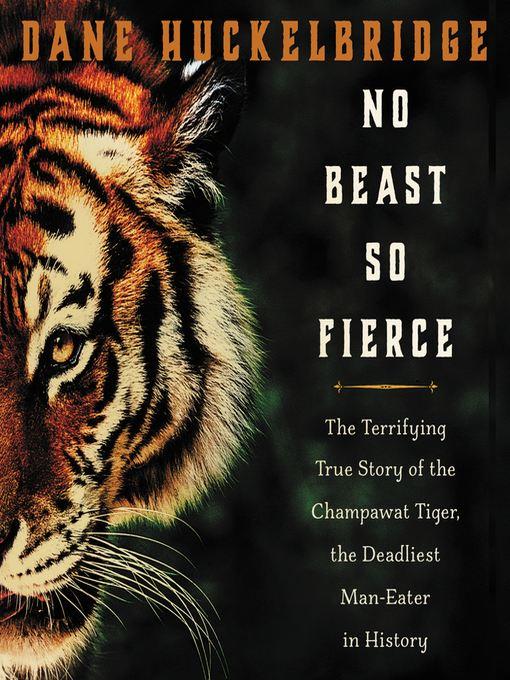
No Beast So Fierce
The Terrifying True Story of the Champawat Tiger, the Deadliest Animal in History
کتاب های مرتبط
- اطلاعات
- نقد و بررسی
- دیدگاه کاربران
نقد و بررسی

Hucklebridge (The United States of Beer; Bourbon: A History of the American Spirit) uses the century-old story of the hunt for a human-eating tiger in British India to explore the consequences of human encroachment on wild habitats. Central to the story is Edward James Corbett, the British railway worker who achieved fame by killing the "Man-Eater of Champawat" in 1907 and went on to extinguish a series of large cats in India in the first half of the 20th century. In the process, he learned of the plight of the Bengal tiger and became a conservationist. Corbett wrote books about his exploits, then used some of the profits to fund a tiger preserve in a national park in India. Hucklebridge notes that tigers had once been cautious around humans and that only when the forests were taken for agriculture and their natural prey disappeared did they begin to hunt humans out of desperation. The author details the fearful power of a tiger attack but closes by stating that it does not match the wanton killing humans have inflicted on such beasts. VERDICT For lovers of history, nature, and adventure stories.--Caren Nichter, Univ. of Tennessee at Martin
Copyright 1 Library Journal, LLC Used with permission.
December 1, 2018
The tale of a killer tiger in the days of the Raj.In November 2018, authorities reported the killing of a female tiger that had killed at least 13 villagers in the hill country of central India. The problem of killer tigers is growing there, reports continue, because critical habitat and suitable prey are scarce. So it was more than a century ago, when, writes Huckelbridge (The United States of Beer: A Freewheeling History of the All-American Drink, 2016, etc.), a tiger called the "Man-Eater of Champawat" killed a reported 436 people. And not just that; in the author's overwrought formulation, that tiger becomes "a serial killer that was not merely content to kidnap victims at night and dismember their bodies, but also insisted on eating their flesh." Well, yes; it's in the job description of a tiger that can't find a deer to bring down. Intriguingly but somewhat clumsily, Huckelbridge joins the tale of the tiger to the history of colonialism and its extractive economies, with deforestation and habitat destruction combining to make of the Champawat tiger "a man-made disaster." Surveying other such killer animals, among them a wolf or feral dog that killed 113 people in France and a Nile crocodile reputed to have killed 300, the author chases down the known facts of the tiger, which had roamed well outside its territory into the foothills of the Himalayas and was hunting the most readily available prey. Its end came at the hands of a game hunter named Jim Corbett, who tracked him down after a long search that turns purple at key moments: "And all at once Jim Corbett understands what's been done to this poor creature, a story written in malice and pain. But the number 436 leaves no room for pity, and twenty feet affords him no chance at escape." Such flourishes are unnecessary given the inherent drama of the story and the nice irony that Corbett would become a leading advocate of tiger conservation.An overwritten narrative that will be of some interest to fans of apex predators.
COPYRIGHT(2018) Kirkus Reviews, ALL RIGHTS RESERVED.

Corey Snow narrates this true story of an angry tiger on a murderous rampage in the Himalayan foothills. He does so with vigor and excitement, bringing across to listeners the panic of villagers in this region during the early twentieth century. Snow infuses the story, based on actual events, with empathy for the wounded Champawat tiger, as she came to be known. He alternates between a warm tone when describing the tiger's dilemma at continued human encroachment on her habitat and an academic one for the details of British colonial history that provide rich historical context. Snow captures the drama of the tracking and hunting by both the tigress and the British young man tasked with stopping her. M.R. � AudioFile 2019, Portland, Maine

Starred review from January 1, 2019
Man-eater. Is there any appellation for a beast?indeed, the largest cat, frightening enough as an apex predator?more terrifying? This is the fascinating tale of the Champawat Tiger, the most fearsome and most successful man-eater, with 436 attributed kills, ever to feast upon humans. It is also the story of the forces that created her, a perfect storm of a previous disabling wound, loss of prey species, and degradation of natural habitat. Huckelbridge (The United States of Beer, 2016) further widens the scope to include British colonialism in India and Nepal and how misguided agricultural and forestry practices, combined with rampant sport hunting, created an ecological disaster. Finally, this is also the saga of Jim Corbett, an Irishman well acquainted with the effects of British rule who, as an avid sportsman, took on the hunt for the man-eating tigress. In a concluding irony, Corbett was among the first to call attention to the plummeting tiger population. This multilayered approach to what is, at heart, the account of Corbett's long-term hunt for the famous man-eater elevates Huckelbridge's book above the sensational "true tale" to stand as a superb work of natural history.(Reprinted with permission of Booklist, copyright 2019, American Library Association.)

























دیدگاه کاربران